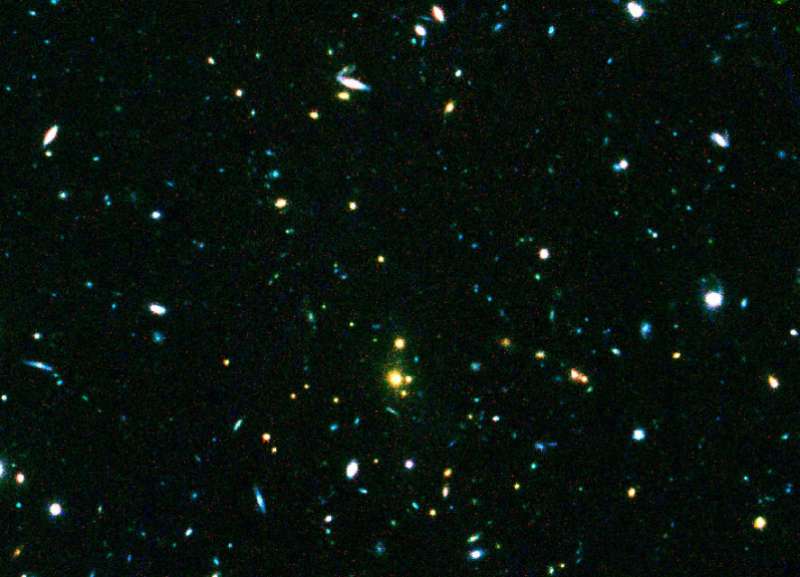A composite image of the galaxy cluster XLSSC 122 using images from the Hubble Space Telescope and European Southern Observatory’s Very Large Telescope. The white contours reveal strong X-ray emission captured by the European Space Agency’s X-ray Multi-Mirror satellite. Credit: Jon Willis.
Using high-powered telescopes including NASA's Hubble Space Telescope, scientists from Canada, the United States and Denmark have captured the clearest image known of a cluster of galaxies from 10 billion years ago in a discovery that provides clues the universe was more evolved than previously thought.
The discovery is the best-case example found so far of the mature, evolved system, says Jon Willis, lead author of research published in Nature and astronomer at the University of Victoria. Willis studies the physical contents of the universe covering many aspects of cosmology and astrophysics.
Q. What is a galaxy cluster and what can they tell us about the universe?
A. A galaxy cluster can be likened to a great city of galaxies, though galaxies themselves are collections of billions of stars all held together by gravity. In simple terms, astrophysics is the study of our universe and our place in it. By studying the stars that make up the galaxies we can tell how old they are and when each galaxy first formed.
Q. What did your team of scientists find?
A. We've discovered what is the most ancient city of galaxies in the universe. It's the clearest snapshot yet of a galaxy cluster—it's like a Rosetta Stone. In the same way, the Rosetta Stone was a glimpse into ancient Egyptian history, this discovery provides clues to understanding the physics of what was going on in that environment billions of years ago. Astronomy is wonderful in that seeing is believing. I don't need to show you an equation; I don't need to show you a complex model. I can show you an image in the sky.
Q. How unique is your discovery?
A. It's the most concentrated, easiest to see and the most prominent out of what's been seen. To put it in context, the universe is 13 billion years old and so the cluster is an old object in a young universe. We are very surprised to see how early the universe produced something so mature. Finding a galaxy cluster so early in the development of the universe tells us that—wow—the universe is capable of amazing things.
Q. Can you provide a simple analogy for this discovery?
A. It's an equivalent of meeting a child who displays all the characteristics of an adult. We have met these young clusters—think the universe was just over three-billion-years old—so we've found it's quite a precocious object and it can teach us about how physics works in the early universe.
Q. You've captured these images using high-powered telescopes. How do you gain access to these tools?
A. Although the Hubble Space Telescope is the most recent telescope we used, which gave us these wonderful views of the cluster, we have used a number of telescopes to get to this discovery. These include the European Space Agency XMM-Newton space observatory, the Canada France Hawaii Telescope and the European Southern Observatory Very Large Telescope.
Q. What's next?
A. We are fortunate that NASA is planning to launch the James Webb Space Telescope, which is the successor to Hubble in late 2020 or early 2021. The first observing proposals are due in May 2020. Rest assured we'll be applying to study this cluster in much more detail.
More information: J. P. Willis et al. Spectroscopic confirmation of a mature galaxy cluster at a redshift of 2, Nature (2020). DOI: 10.1038/s41586-019-1829-4
Journal information: Nature
Provided by University of Victoria
























